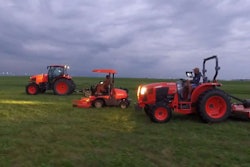 In late winter, an arborist has a clearer view of branches while determining which need to be removed and which areas are diseased or problematic.
In late winter, an arborist has a clearer view of branches while determining which need to be removed and which areas are diseased or problematic.Photo: Friendly Tree Service
It may be winter but your clients’ trees need care during every season. Pruning during the dormant season, when buds have yet to open and trees are in hibernation, provides numerous benefits.
“Applying proper pruning techniques at the correct time of year is an essential component of maintaining urban forests,” says Keith Wood, community forestry program manager for the Colorado State Forest Service. “By being proactive and pruning trees during the late winter, residents can help maintain the health, appearance and safety of their trees for the long term.”
Well-maintained trees are an asset to any property, and can actually increase a property’s value by up to 14 percent. A healthy tree in good condition can be worth up to $10,000, proving that maintaining your landscape truly is a good investment.
Prune in late winter, early spring
In the dormant season, foliage isn’t an issue. An arborist will have a clearer picture of what branches need to be removed and which areas are diseased or problematic. Since branching patterns are easier to see in the dormant season, arborists can also perform structural pruning more easily and make more precise cuts.
In the winter months, when outdoor living is at a minimum, an arborist won’t need to worry about disturbing people on the property, garden beds aren’t in bloom and the overall impact to the property is substantially less significant.
During the warm season, fresh cuts are more vulnerable to insects, which are hosts to tree-killing bacteria and fungi. Pruning during the dormant season protects your trees from the spread of disease and makes them less vulnerable to attack once temperatures heat up and insect activity increases.
Some trees, like oaks, should only be pruned during the dormant season because they are especially susceptible to oak wilt disease, which is known to spread extremely fast in the spring and summer.
First, do no harm
When you prune a tree, you are actually wounding it. Like people, trees need adequate time to recover from their wounds and bounce back. The dormant season, when trees are already at rest, is the best time for them to heal.
Pruning trees before new growth begins exposes them to less stress and allows for more robust new growth in the spring.
Without dense foliage in the way, arborists can get a better picture of the tree’s storm readiness, meaning how it will handle extreme weather. Removing weak and vulnerable branches gives trees more structural strength to withstand severe weather, especially wet spring snows and high winds.
Purposeful pruning opens the tree’s canopy, allowing more sunlight to reach grass and other plants at a time when light is scarce.
Dormant season pruning is generally more efficient than pruning during other seasons. Bare limbs allow for better access to trees, which means pruning takes less time. Bare branches are also much lighter than those laden with foliage, which makes them easier to handle, with less potential for damage.
Trees benefit yours and your clients’ property by providing shade, oxygen and aesthetic beauty – now is the time to say “thanks” by giving them the care they need. Proper pruning paves the way for healthy spring growth, giving your trees the best chance to thrive.
EDITOR’S NOTE: This article was written by John Lang. Lang is a Certified Arborist with Friendly Tree Service, a family-owned company in New Jersey that has been providing expert tree care for more than 25 years.









